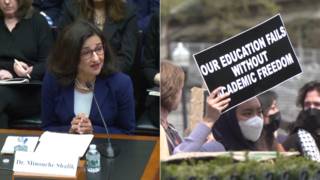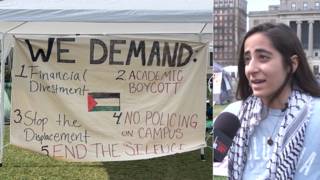
Related
Guests
- Flint Taylorattorney with People’s Law Office who has represented survivors of police torture in Chicago for nearly half a century. His new book is titled The Torture Machine: Racism and Police Violence in Chicago.
We look at the Chicago Police Department’s long history of violence against African Americans, from the murder of Black Panther Fred Hampton to the reign of torture overseen by commander Jon Burge. The brutality of the Chicago police force is laid bare in a new book by leading civil rights lawyer Flint Taylor. It’s called “The Torture Machine: Racism and Police Violence in Chicago.” The book exposes decades of corruption and cover-ups in the Chicago Police Department. We speak with Flint Taylor, who has represented survivors of police brutality in Chicago for nearly half a century.
More from this Interview
- Part 1: The Torture Machine: Flint Taylor on Chicago Police Brutality from Fred Hampton to Today
- Part 2: The Roots of Police Violence in Chicago: How Cops Have Targeted Communities of Color for Decades
- Part 3: Court Upholds Chicago Officer’s 7-Year Sentence for Killing Unarmed Black Teenager Laquan McDonald
Transcript
AMY GOODMAN: This is Democracy Now! I’m Amy Goodman, with Juan González.
JUAN GONZÁLEZ: Well, we spend the rest of the hour in Chicago, where the Illinois Supreme Court has let stand a less than 7-year prison sentence for former police officer Jason Van Dyke, who was found guilty last year of second-degree murder for killing African-American teenager Laquan McDonald in 2014. The Illinois Supreme Court denied a request by the state’s attorney general to resentence Van Dyke on Tuesday. Van Dyke, who is white, was found guilty on 16 counts of aggravated battery—one count for each of the 16 bullets he fired at McDonald. Illinois Attorney General Kwame Raoul petitioned the state Supreme Court to vacate Van Dyke’s second-degree murder sentence and instead impose a sentence on each of the 16 counts. If the petition had been granted, Van Dyke could have faced to up 96 years in prison.
The news that Van Dyke will not be resentenced has sparked criticism throughout Chicago. The city’s mayoral candidates, who are both African-American women, have spoken out against the decision. Lori Lightfoot, the front-runner in the race, tweeted, quote, “Today’s ruling is the latest disappointment in the Jason Van Dyke sentencing, and a sad reminder of the work we must do to create a system that is free of institutional racism and truly holds police accountable for their misconduct, including criminal acts. We cannot build trust between police and the communities they serve if officers who commit crimes are not held to the same standards as [other defendants].” Lightfoot and her opponent, Cook County Board President Toni Preckwinkle, both have vowed to reform Chicago’s Police Department. Van Dyke is the first Chicago police officer to be sentenced for an on-duty shooting in half a century.
AMY GOODMAN: The decision is the latest in the struggle by activists, lawyers, journalists to hold the Chicago Police Department accountable for its long history of violence against the city’s citizens, particularly African-American men. Much of that history is chronicled in a new book by a leading Chicago lawyer fighting police torture. The Torture Machine: Racism and Police Violence in Chicago exposes decades of corruption and cover-ups in the Chicago Police Department, from the murder of Black Panther leader Fred Hampton and Mark Clark to the reign of torture overseen by Commander Jon Burge. Under Burge’s reign, from 1972 to ’91, more than 200 people, most of them African-American, were tortured with tactics including electric shock and suffocation.
We’re joined now by the book’s author, Flint Taylor, an attorney with People’s Law Office who has represented survivors of police torture in Chicago for more than 25 years.
Flint, welcome back to Democracy Now! Why did you name your book The Torture Machine?
FLINT TAYLOR: Well, thank you, Amy and Juan. It’s a pleasure to be back with you.
I named it The Torture Machine for two different but related reasons. First of all is rather obvious. On the cover, the torture machine, that was the electric shock box that the notorious Commander Jon Burge and his men used on many African-American suspects over that 20-year period that you just mentioned. But also “the torture machine” refers to Chicago’s machine, the notorious political machine, often known as the Daley machine and the Democratic machine, here in the city, which not only countenanced this torture, covered it up, but also was involved at the highest levels of the police department and, yes, the State’s Attorney’s Office, when Richard M. Daley was the state’s attorney of Cook County—were involved in this conspiracy, this scandal, that has gone on for so many decades in this city.
JUAN GONZÁLEZ: Well, Flint, I want to, first, congratulate you on the book. It is really a riveting account. It’s almost a forensic analysis of decades of collusion between judges, politicians, prosecutors and the police to basically engage in systemic human rights violation. But you start the book with an incident that, for many young people today, is not even part of history, but it’s not often covered history. And you make the statement that the killing of Fred Hampton and Mark Clark really was a seminal moment in the development of Chicago, in the modern history of Chicago. And I’m wondering if you could first give us a sense of why you believe that’s so, and then we’re going to do a clip of a documentary, from The Weather Underground, about that, the house where Fred Hampton was killed.
FLINT TAYLOR: Yes. On December 4th, 1969, 14 Chicago police officers working under the control of the state’s attorney of Cook County—at that time, Edward Hanrahan—raided a West Side apartment where Black Panthers were sleeping. And one of those Black Panthers was the chairman of the Black Panther Party, Fred Hampton, a charismatic young leader, who was targeted not only by the police, but by, it turns out, the FBI. And that raid, which was covered up, was claimed to be at first a shootout, was later shown to be a total shoot-in. And then, over the years, as we and others were able to litigate a case in federal court, we were able to show not only that this was a vicious, racist attack on the Panthers and its leadership, where two men were killed and many others wounded, but it was part and parcel of the FBI’s COINTELPRO program, the counterintelligence program devised and implemented by J. Edgar Hoover over the years, which in the late ’60s targeted the Black Panther Party, and specifically Fred Hampton in Chicago, and, in fact, that the raid on the apartment was part of this COINTELPRO program.
JUAN GONZÁLEZ: And, of course, you make the point in your book that that was the beginning of the resistance, mass resistance, of the black community, that eventually led to the election of Harold Washington as the first black mayor of Chicago. But I want to turn to the clip from the documentary The Weather Underground about the murder of Black Panther Fred Hampton nearly 50 years ago, on December 4th, 1969. This clip begins with Fred Hampton.
FRED HAMPTON: So we say—we always say in the Black Panther Party that they can do anything they want to to us. We might not be back. I might be in jail. I might be anywhere. But when I leave, you’ll remember I said, with the last words on my lips, that I am a revolutionary.
WALTER CRONKITE: In Chicago today, two Black Panthers were killed as police raided a Panther stronghold. Police arrived at Fred Hampton’s West Side apartment at 4:45 this morning. They had a search warrant authorizing them to look for illegal weapons. The State’s Attorney’s Office says that Hampton and another man were killed in the 15-minute gun battle which followed.
BOBBY RUSH: The pigs murdered Deputy Chairman Fred Hampton while he lay in bed. Their lies, their oinking to the people won’t—can’t bear up to the evidence that we have that they murdered our deputy chairman in cold blood as he lay in his bed asleep.
BERNARDINE DOHRN: The Panther Party organized tours of the apartment that they were in when they were murdered, and I went with a group of people from the SDS national office, which is a couple of blocks away.
BLACK PANTHER TOUR GUIDE: Don’t touch nothing. Don’t move nothing, because we want to keep everything just the way it is.
BERNARDINE DOHRN: It was a scene of carnage. It was a scene of war. You see this door ridden with bullets, not little bullet holes, but shattered.
BLACK PANTHER TOUR GUIDE: The room where first brother Mark Clark was murdered at.
BERNARDINE DOHRN: You walk through a living room into the bedroom, and there’s a mattress soaked in his blood, red blood down the floor.
SKIP ANDREW: Anyone who went through that apartment and examined the evidence that was remaining there could come to only one conclusion, and that is that Fred Hampton, 21 years old and a member of a militant, well-known militant group, was murdered in his bed probably as he lay asleep.
THOMAS STRIETER: This blatant act of legitimatized murder strips all credibility from law enforcement. In the context of other acts against militant blacks in recent months, it suggests an official policy of systematic repression.
JUAN GONZÁLEZ: That was from the documentary The Weather Underground, directed by Sam Green and Bill Siegel. And so, Flint, the reality was, as you document in your book, that this was actually a direct assassination and that there was a long struggle, on your part, to—because you were there. You were able to get to the house the very day that Hampton was killed. Could you talk about this conspiracy to kill one of the rising radical leaders of the black community?
FLINT TAYLOR: Well, we see now—and it was uncovered during our trial in the ’70s—that the COINTELPRO program targeted black liberation organizations and leaders. And they specifically named targets—Dr. King, Stokely Carmichael, Rap Brown, Elijah Muhammad—and pointed to Malcolm X, as well. And as the Panthers rose and became powerful, first in Oakland and later in Chicago—as you can see from the clip what a charismatic, young leader, at 21, Fred Hampton was—Hoover and his people focused on the Black Panther Party and, specifically in Chicago, on Fred Hampton.
They had an informant in the Black Panther Party by the name of William O’Neal. He sketched out a floor plan that showed where Hampton would be sleeping. They went to the apartment. They supplied that floor plan to the police—the FBI did. They went to the apartment in the early-morning hours. And Fred was asleep. It appeared that he had been drugged by O’Neal or some other agent. And he was murdered in his bed.
Over the years, we uncovered documents that showed this floor plan. That was all covered up, as well. It showed that the FBI took credit for this raid as part of its COINTELPRO program. And it showed even that O’Neal, after the raid, was given by Hoover and the people in Chicago a $300 bonus, what we later called the “30 pieces of silver” for the informant, O’Neal, for setting up the raid. So, he was receiving from Hoover a bonus for the success of the raid at the same time he was serving as a pallbearer in Fred Hampton’s funeral.
AMY GOODMAN: Flint Taylor, you pursued this case civilly for 13 years. What came out of it?
FLINT TAYLOR: Well, a lot of what I’ve just mentioned came out of it. The narrative shifted over the years, thanks to the community, thanks to the Panthers and thanks to the lawsuit that we filed. And as you could hear from the clip, the position that the police took—and they thought they were going to get away with scot-free—was that this was a shootout, that these were vicious Black Panthers, all of that. Well, because we and the Panthers went to that apartment, we were able to show that it was a shoot-in. We were able to change the narrative to the fact that it was an unjustified and violent shoot-in by the police. But over the years, as we were able to join the FBI in the case, we were able to uncover these FBI documents that showed that, yes, it was not just a murder, it was not just a shoot-in, but it was an assassination. It was a political assassination straight from Washington and the FBI.
JUAN GONZÁLEZ: And, Flint, very shortly after the murder of Fred Hampton, you got involved in another case of the Wilson brothers, and which began the uncovering of the Jon Burge scandal, that, again, would take you decades, really, to finally get some measure of justice. Could you talk about that, the Wilson case?
FLINT TAYLOR: Yes. The Wilson case arose in February of 1982. Two white police officers were shot and killed. The two black perpetrators had escaped. And the city of Chicago, under Jane Byrne and Police Superintendent Brzeczek, set out on the most vicious and terroristic manhunt in the history of the city. They terrorized the black community. They kicked in doors. They dragged people out of their houses. If they thought that they had some information about the killings, they tortured them. They tortured them with suffocation. They tortured them with all kinds of medieval types of torture. They finally found the two people who the eyewitness identified as the persons who were involved in the crime. And the person who was identified as the shooter was Andrew Wilson.
Andrew Wilson was taken back to the police headquarters on the South Side of Chicago. And this notorious commander, who at that time was a lieutenant in charge of the manhunt, by the name of Jon Burge, led a torture of Andrew Wilson that included electric shock with the torture machine, that is mentioned and depicted in my book, and suffocation with a bag. They handcuffed him across an old, ribbed steam radiator and electric-shocked him so that he was burned across his chest. And they also burned him with cigarettes, beat him and got a confession from him.
This came out at that time, but nobody really cared. The state’s attorney of Cook County, Richard Daley, was informed specifically by a doctor and the police superintendent about this torture, and he chose to do nothing about it. Because he did nothing about it, Burge was able to, in the next 10 years, torture another 75 individuals—all African-American men.
And a few years after that, Andrew Wilson, who had been sentenced to death, filed a pro se complaint in federal court challenging his torture and suing Burge. That’s how we got involved. During his trial, an anonymous police source, who we later dubbed as “Deep Badge,” started to give me information that laid out exactly the map of what had happened, the systemic nature of the torture, the fact that Daley and his surrogates were involved, that the police superintendent, that the mayor were all involved.
And we followed that map, basically, for the next 20, 30 years, even as we sit here today, to uncover evidence that supported the idea that this was a systemic torture. This was something that sent people to death row. This was something that convicted innocent people. And, ultimately, all of this led to Burge’s firing. It led to, many, many years later, his conviction for obstruction of justice for lying about the torture. And, of course, it led to the remarkable reparations that the city of Chicago granted to the survivors of police torture and their families here a couple of years ago.
AMY GOODMAN: Flint Taylor, we’re going to break and then come back to this conversation, and we’ll also be joined by Lilia Fernández. This is Democracy Now! Flint Taylor, attorney with People’s Law Office, known as the PLO, has represented survivors of police torture in Chicago for nearly half a century. His new book, The Torture Machine: Racism and Police Violence in Chicago. When we come back, Lilia Fernández will join us, as well. Stay with us.











Media Options